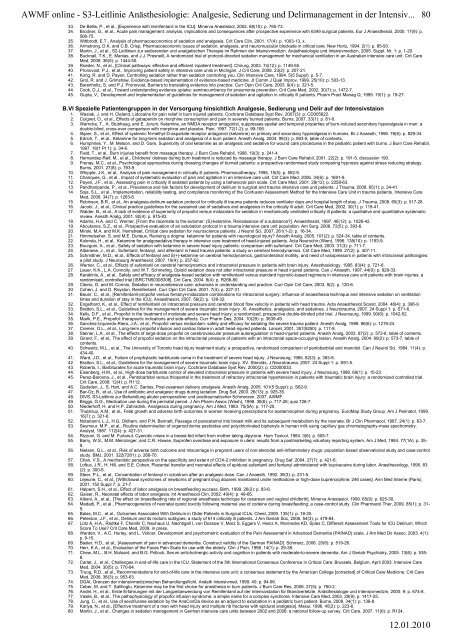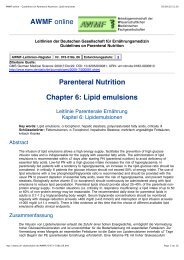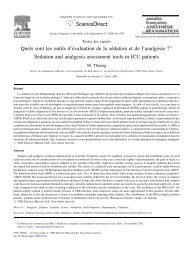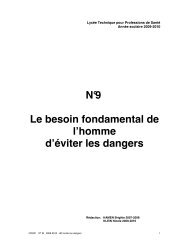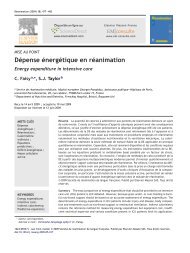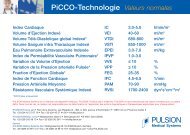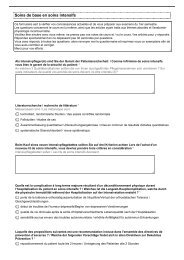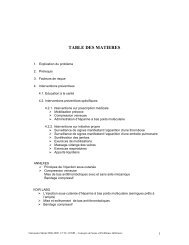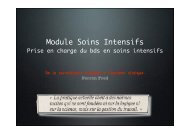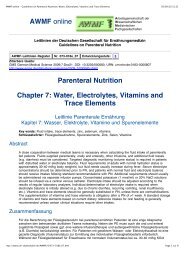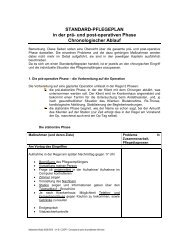Analgesie, Sedierung und Delirmanagement in der ... - Amazon S3
Analgesie, Sedierung und Delirmanagement in der ... - Amazon S3
Analgesie, Sedierung und Delirmanagement in der ... - Amazon S3
Erfolgreiche ePaper selbst erstellen
Machen Sie aus Ihren PDF Publikationen ein blätterbares Flipbook mit unserer einzigartigen Google optimierten e-Paper Software.
AWMF onl<strong>in</strong>e - <strong>S3</strong>-Leitl<strong>in</strong>ie Anästhesiologie: <strong>Analgesie</strong>, <strong>Sedierung</strong> <strong>und</strong> <strong>Delirmanagement</strong> <strong>in</strong> <strong>der</strong> Intensiv...<br />
33. De Bellis, P., et al., [Experience with remifentanil <strong>in</strong> the ICU]. M<strong>in</strong>erva Anestesiol, 2002. 68(10): p. 765-73.<br />
34. Brodner, G., et al., Acute pa<strong>in</strong> management: analysis, implications and consequences after prospective experience with 6349 surgical patients. Eur J Anaesthesiol, 2000. 17(9): p.<br />
566-75.<br />
35. Wittbrodt, E.T., Analysis of pharmacoeconomics of sedation and analgesia. Crit Care Cl<strong>in</strong>, 2001. 17(4): p. 1003-13, x.<br />
36. Armstrong, D.K. and C.B. Crisp, Pharmacoeconomic issues of sedation, analgesia, and neuromuscular blockade <strong>in</strong> critical care. New Horiz, 1994. 2(1): p. 85-93.<br />
37. Mart<strong>in</strong>, J., et al., S2-Leitl<strong>in</strong>ien zur sedierenden <strong>und</strong> analgetischen Therapie im Rahmen <strong>der</strong> Intensivmediz<strong>in</strong>. Anästhesiologie <strong>und</strong> Intensivmediz<strong>in</strong>, 2005. Suppl. Nr. 1: p. 1-20.<br />
38. Bucknall, T.K., E. Manias, and J.J. Presneill, A randomized trial of protocol-directed sedation management for mechanical ventilation <strong>in</strong> an Australian <strong>in</strong>tensive care unit. Crit Care<br />
Med, 2008. 36(5): p. 1444-50.<br />
39. Roe<strong>der</strong>, N., et al., [Cl<strong>in</strong>ical pathways: effective and efficient <strong>in</strong>patient treatment]. Chirurg, 2003. 74(12): p. 1149-55.<br />
40. Pronovost, P.J., et al., Improv<strong>in</strong>g patient safety <strong>in</strong> <strong>in</strong>tensive care units <strong>in</strong> Michigan. J Crit Care, 2008. 23(2): p. 207-21.<br />
41. Kong, R. and D. Payen, Controll<strong>in</strong>g sedation rather than sedation controll<strong>in</strong>g you. Cl<strong>in</strong> Intensive Care, 1994. 5(5 Suppl): p. 5-7.<br />
42. Grol, R. and J. Grimshaw, Evidence-based implementation of evidence-based medic<strong>in</strong>e. Jt Comm J Qual Improv, 1999. 25(10): p. 503-13.<br />
43. Berenholtz, S. and P.J. Pronovost, Barriers to translat<strong>in</strong>g evidence <strong>in</strong>to practice. Curr Op<strong>in</strong> Crit Care, 2003. 9(4): p. 321-5.<br />
44. Cook, D.J., et al., Toward <strong>und</strong>erstand<strong>in</strong>g evidence uptake: semirecumbency for pneumonia prevention. Crit Care Med, 2002. 30(7): p. 1472-7.<br />
45. Gupta, V., Development and implementation of guidel<strong>in</strong>es for management of sedation and agitation <strong>in</strong> critically ill patients. Pharm Pract Manag Q, 1999. 19(1): p. 19-27.<br />
B.VI Spezielle Patientengruppen <strong>in</strong> <strong>der</strong> Versorgung h<strong>in</strong>sichtlich <strong>Analgesie</strong>, <strong>Sedierung</strong> <strong>und</strong> Delir auf <strong>der</strong> Intensivstaion<br />
1. Wasiak, J. and H. Cleland, Lidoca<strong>in</strong>e for pa<strong>in</strong> relief <strong>in</strong> burn <strong>in</strong>jured patients. Cochrane Database Syst Rev, 2007(3): p. CD005622.<br />
2. Cuignet, O., et al., Effects of gabapent<strong>in</strong> on morph<strong>in</strong>e consumption and pa<strong>in</strong> <strong>in</strong> severely burned patients. Burns, 2007. 33(1): p. 81-6.<br />
3. Warncke, T., A. Stubhaug, and E. Jorum, Ketam<strong>in</strong>e, an NMDA receptor antagonist, suppresses spatial and temporal properties of burn-<strong>in</strong>duced secondary hyperalgesia <strong>in</strong> man: a<br />
double-bl<strong>in</strong>d, cross-over comparison with morph<strong>in</strong>e and placebo. Pa<strong>in</strong>, 1997. 72(1-2): p. 99-106.<br />
4. Ilkjaer, S., et al., Effect of systemic N-methyl-D-aspartate receptor antagonist (ketam<strong>in</strong>e) on primary and secondary hyperalgesia <strong>in</strong> humans. Br J Anaesth, 1996. 76(6): p. 829-34.<br />
5. Edrich, T., et al., Ketam<strong>in</strong>e for long-term sedation and analgesia of a burn patient. Anesth Analg, 2004. 99(3): p. 893-5, table of contents.<br />
6. Humphries, Y., M. Melson, and D. Gore, Superiority of oral ketam<strong>in</strong>e as an analgesic and sedative for wo<strong>und</strong> care procedures <strong>in</strong> the pediatric patient with burns. J Burn Care Rehabil,<br />
1997. 18(1 Pt 1): p. 34-6.<br />
7. Field, T., et al., Burn <strong>in</strong>juries benefit from massage therapy. J Burn Care Rehabil, 1998. 19(3): p. 241-4.<br />
8. Hernandez-Reif, M., et al., Childrens' distress dur<strong>in</strong>g burn treatment is reduced by massage therapy. J Burn Care Rehabil, 2001. 22(2): p. 191-5; discussion 190.<br />
9. Frenay, M.C., et al., Psychological approaches dur<strong>in</strong>g dress<strong>in</strong>g changes of burned patients: a prospective randomised study compar<strong>in</strong>g hypnosis aga<strong>in</strong>st stress reduc<strong>in</strong>g strategy.<br />
Burns, 2001. 27(8): p. 793-9.<br />
10. Whipple, J.K., et al., Analysis of pa<strong>in</strong> management <strong>in</strong> critically ill patients. Pharmacotherapy, 1995. 15(5): p. 592-9.<br />
11. Chanques, G., et al., Impact of systematic evaluation of pa<strong>in</strong> and agitation <strong>in</strong> an <strong>in</strong>tensive care unit. Crit Care Med, 2006. 34(6): p. 1691-9.<br />
12. Payen, J.F., et al., Assess<strong>in</strong>g pa<strong>in</strong> <strong>in</strong> critically ill sedated patients by us<strong>in</strong>g a behavioral pa<strong>in</strong> scale. Crit Care Med, 2001. 29(12): p. 2258-63.<br />
13. Pandharipande, P., et al., Prevalence and risk factors for development of delirium <strong>in</strong> surgical and trauma <strong>in</strong>tensive care unit patients. J Trauma, 2008. 65(1): p. 34-41.<br />
14. Soja, S.L., et al., Implementation, reliability test<strong>in</strong>g, and compliance monitor<strong>in</strong>g of the Confusion Assessment Method for the Intensive Care Unit <strong>in</strong> trauma patients. Intensive Care<br />
Med, 2008. 34(7): p. 1263-8.<br />
15. Rob<strong>in</strong>son, B.R., et al., An analgesia-delirium-sedation protocol for critically ill trauma patients reduces ventilator days and hospital length of stay. J Trauma, 2008. 65(3): p. 517-26.<br />
16. Jacobi, J., et al., Cl<strong>in</strong>ical practice guidel<strong>in</strong>es for the susta<strong>in</strong>ed use of sedatives and analgesics <strong>in</strong> the critically ill adult. Crit Care Med, 2002. 30(1): p. 119-41.<br />
17. Wal<strong>der</strong>, B., et al., A lack of evidence of superiority of propofol versus midazolam for sedation <strong>in</strong> mechanically ventilated critically ill patients: a qualitative and quantitative systematic<br />
review. Anesth Analg, 2001. 92(4): p. 975-83.<br />
18. Adams, H.A. and C. Werner, [From the racemate to the eutomer: (S)-ketam<strong>in</strong>e. Renaissance of a substance]. Anaesthesist, 1997. 46(12): p. 1026-42.<br />
19. Aboutanos, S.Z., et al., Prospective evaluation of an extubation protocol <strong>in</strong> a trauma <strong>in</strong>tensive care unit population. Am Surg, 2006. 72(5): p. 393-6.<br />
20. Mirski, M.A. and M.K. Hemstreet, Critical care sedation for neuroscience patients. J Neurol Sci, 2007. 261(1-2): p. 16-34.<br />
21. Himmelseher, S. and M.E. Durieux, Revis<strong>in</strong>g a dogma: ketam<strong>in</strong>e for patients with neurological <strong>in</strong>jury Anesth Analg, 2005. 101(2): p. 524-34, table of contents.<br />
22. Kolenda, H., et al., Ketam<strong>in</strong>e for analgosedative therapy <strong>in</strong> <strong>in</strong>tensive care treatment of head-<strong>in</strong>jured patients. Acta Neurochir (Wien), 1996. 138(10): p. 1193-9.<br />
23. Bourgo<strong>in</strong>, A., et al., Safety of sedation with ketam<strong>in</strong>e <strong>in</strong> severe head <strong>in</strong>jury patients: comparison with sufentanil. Crit Care Med, 2003. 31(3): p. 711-7.<br />
24. Albanese, J., et al., Sufentanil, fentanyl, and alfentanil <strong>in</strong> head trauma patients: a study on cerebral hemodynamics. Crit Care Med, 1999. 27(2): p. 407-11.<br />
25. Schmittner, M.D., et al., Effects of fentanyl and S(+)-ketam<strong>in</strong>e on cerebral hemodynamics, gastro<strong>in</strong>test<strong>in</strong>al motility, and need of vasopressors <strong>in</strong> patients with <strong>in</strong>tracranial pathologies:<br />
a pilot study. J Neurosurg Anesthesiol, 2007. 19(4): p. 257-62.<br />
26. Werner, C., et al., Effects of sufentanil on cerebral hemodynamics and <strong>in</strong>tracranial pressure <strong>in</strong> patients with bra<strong>in</strong> <strong>in</strong>jury. Anesthesiology, 1995. 83(4): p. 721-6.<br />
27. Lauer, K.K., L.A. Connolly, and W.T. Schmel<strong>in</strong>g, Opioid sedation does not alter <strong>in</strong>tracranial pressure <strong>in</strong> head <strong>in</strong>jured patients. Can J Anaesth, 1997. 44(9): p. 929-33.<br />
28. Karab<strong>in</strong>is, A., et al., Safety and efficacy of analgesia-based sedation with remifentanil versus standard hypnotic-based regimens <strong>in</strong> <strong>in</strong>tensive care unit patients with bra<strong>in</strong> <strong>in</strong>juries: a<br />
randomised, controlled trial [ISRCTN50308308]. Crit Care, 2004. 8(4): p. R268-80.<br />
29. Citerio, G. and M. Cormio, Sedation <strong>in</strong> neuro<strong>in</strong>tensive care: advances <strong>in</strong> <strong>und</strong>erstand<strong>in</strong>g and practice. Curr Op<strong>in</strong> Crit Care, 2003. 9(2): p. 120-6.<br />
30. Cohen, J. and D. Royston, Remifentanil. Curr Op<strong>in</strong> Crit Care, 2001. 7(4): p. 227-31.<br />
31. Bauer, C., et al., [Remifentanil-propofol versus fentanyl-midazolam comb<strong>in</strong>ations for <strong>in</strong>tracranial surgery: <strong>in</strong>fluence of anaesthesia technique and <strong>in</strong>tensive sedation on ventilation<br />
times and duration of stay <strong>in</strong> the ICU]. Anaesthesist, 2007. 56(2): p. 128-32.<br />
32. Engelhard, K., et al., Effect of remifentanil on <strong>in</strong>tracranial pressure and cerebral blood flow velocity <strong>in</strong> patients with head trauma. Acta Anaesthesiol Scand, 2004. 48(4): p. 396-9.<br />
33. Bratton, S.L., et al., Guidel<strong>in</strong>es for the management of severe traumatic bra<strong>in</strong> <strong>in</strong>jury. XI. Anesthetics, analgesics, and sedatives. J Neurotrauma, 2007. 24 Suppl 1: p. S71-6.<br />
34. Kelly, D.F., et al., Propofol <strong>in</strong> the treatment of mo<strong>der</strong>ate and severe head <strong>in</strong>jury: a randomized, prospective double-bl<strong>in</strong>ded pilot trial. J Neurosurg, 1999. 90(6): p. 1042-52.<br />
35. Marik, P.E., Propofol: therapeutic <strong>in</strong>dications and side-effects. Curr Pharm Des, 2004. 10(29): p. 3639-49.<br />
36. Sanchez-Izquierdo-Riera, J.A., et al., Propofol versus midazolam: safety and efficacy for sedat<strong>in</strong>g the severe trauma patient. Anesth Analg, 1998. 86(6): p. 1219-24.<br />
37. Cremer, O.L., et al., Long-term propofol <strong>in</strong>fusion and cardiac failure <strong>in</strong> adult head-<strong>in</strong>jured patients. Lancet, 2001. 357(9250): p. 117-8.<br />
38. Ste<strong>in</strong>er, L.A., et al., The effects of large-dose propofol on cerebrovascular pressure autoregulation <strong>in</strong> head-<strong>in</strong>jured patients. Anesth Analg, 2003. 97(2): p. 572-6, table of contents.<br />
39. Girard, F., et al., The effect of propofol sedation on the <strong>in</strong>tracranial pressure of patients with an <strong>in</strong>tracranial space-occupy<strong>in</strong>g lesion. Anesth Analg, 2004. 99(2): p. 573-7, table of<br />
contents.<br />
40. Schwartz, M.L., et al., The University of Toronto head <strong>in</strong>jury treatment study: a prospective, randomized comparison of pentobarbital and mannitol. Can J Neurol Sci, 1984. 11(4): p.<br />
434-40.<br />
41. Ward, J.D., et al., Failure of prophylactic barbiturate coma <strong>in</strong> the treatment of severe head <strong>in</strong>jury. J Neurosurg, 1985. 62(3): p. 383-8.<br />
42. Bratton, S.L., et al., Guidel<strong>in</strong>es for the management of severe traumatic bra<strong>in</strong> <strong>in</strong>jury. XV. Steroids. J Neurotrauma, 2007. 24 Suppl 1: p. S91-5.<br />
43. Roberts, I., Barbiturates for acute traumatic bra<strong>in</strong> <strong>in</strong>jury. Cochrane Database Syst Rev, 2000(2): p. CD000033.<br />
44. Eisenberg, H.M., et al., High-dose barbiturate control of elevated <strong>in</strong>tracranial pressure <strong>in</strong> patients with severe head <strong>in</strong>jury. J Neurosurg, 1988. 69(1): p. 15-23.<br />
45. Perez-Barcena, J., et al., Pentobarbital versus thiopental <strong>in</strong> the treatment of refractory <strong>in</strong>tracranial hypertension <strong>in</strong> patients with traumatic bra<strong>in</strong> <strong>in</strong>jury: a randomized controlled trial.<br />
Crit Care, 2008. 12(4): p. R112.<br />
46. Gadsden, J., S. Hart, and A.C. Santos, Post-cesarean delivery analgesia. Anesth Analg, 2005. 101(5 Suppl): p. S62-9.<br />
47. Bar-Oz, B., et al., Use of antibiotic and analgesic drugs dur<strong>in</strong>g lactation. Drug Saf, 2003. 26(13): p. 925-35.<br />
48. DIVS, <strong>S3</strong>-Leitl<strong>in</strong>ie zur Behandlung akuter perioperativer <strong>und</strong> posttraumatischer Schmerzen. 2007, AWMF.<br />
49. Briggs, G.G., Medication use dur<strong>in</strong>g the per<strong>in</strong>atal period. J Am Pharm Assoc (Wash), 1998. 38(6): p. 717-26; quiz 726-7.<br />
50. Nie<strong>der</strong>hoff, H. and H.P. Zahradnik, Analgesics dur<strong>in</strong>g pregnancy. Am J Med, 1983. 75(5A): p. 117-20.<br />
51. Thulstrup, A.M., et al., Fetal growth and adverse birth outcomes <strong>in</strong> women receiv<strong>in</strong>g prescriptions for acetam<strong>in</strong>ophen dur<strong>in</strong>g pregnancy. EuroMap Study Group. Am J Per<strong>in</strong>atol, 1999.<br />
16(7): p. 321-6.<br />
52. Notarianni, L.J., H.G. Oldham, and P.N. Bennett, Passage of paracetamol <strong>in</strong>to breast milk and its subsequent metabolism by the neonate. Br J Cl<strong>in</strong> Pharmacol, 1987. 24(1): p. 63-7.<br />
53. Seymour, M.P., et al., Rout<strong>in</strong>e determ<strong>in</strong>ation of organochlor<strong>in</strong>e pesticides and polychlor<strong>in</strong>ated biphenyls <strong>in</strong> human milk us<strong>in</strong>g capillary gas chromatography-mass spectrometry.<br />
Analyst, 1987. 112(4): p. 427-31.<br />
54. Rizzoni, G. and M. Furlanut, Cyanotic crises <strong>in</strong> a breast-fed <strong>in</strong>fant from mother tak<strong>in</strong>g dipyrone. Hum Toxicol, 1984. 3(6): p. 505-7.<br />
55. Barry, W.S., M.M. Me<strong>in</strong>z<strong>in</strong>ger, and C.R. Howse, Ibuprofen overdose and exposure <strong>in</strong> utero: results from a postmarket<strong>in</strong>g voluntary report<strong>in</strong>g system. Am J Med, 1984. 77(1A): p. 35-<br />
9.<br />
56. Nielsen, G.L., et al., Risk of adverse birth outcome and miscarriage <strong>in</strong> pregnant users of non-steroidal anti-<strong>in</strong>flammatory drugs: population based observational study and case-control<br />
study. BMJ, 2001. 322(7281): p. 266-70.<br />
57. Chan, V.S., A mechanistic perspective on the specificity and extent of COX-2 <strong>in</strong>hibition <strong>in</strong> pregnancy. Drug Saf, 2004. 27(7): p. 421-6.<br />
58. Loftus, J.R., H. Hill, and S.E. Cohen, Placental transfer and neonatal effects of epidural sufentanil and fentanyl adm<strong>in</strong>istered with bupivaca<strong>in</strong>e dur<strong>in</strong>g labor. Anesthesiology, 1995. 83<br />
(2): p. 300-8.<br />
59. Steer, P.L., et al., Concentration of fentanyl <strong>in</strong> colostrum after an analgesic dose. Can J Anaesth, 1992. 39(3): p. 231-5.<br />
60. Lejeune, C., et al., [Withdrawal syndromes of newborns of pregnant drug abusers ma<strong>in</strong>ta<strong>in</strong>ed <strong>und</strong>er methadone or high-dose buprenorph<strong>in</strong>e: 246 cases]. Ann Med Interne (Paris),<br />
2001. 152 Suppl 7: p. 21-7.<br />
61. Halpern, S.H., et al., Effect of labor analgesia on breastfeed<strong>in</strong>g success. Birth, 1999. 26(2): p. 83-8.<br />
62. Gaiser, R., Neonatal effects of labor analgesia. Int Anesthesiol Cl<strong>in</strong>, 2002. 40(4): p. 49-65.<br />
63. Albani, A., et al., [The effect on breastfeed<strong>in</strong>g rate of regional anesthesia technique for cesarean and vag<strong>in</strong>al childbirth]. M<strong>in</strong>erva Anestesiol, 1999. 65(9): p. 625-30.<br />
64. Madadi, P., et al., Pharmacogenetics of neonatal opioid toxicity follow<strong>in</strong>g maternal use of code<strong>in</strong>e dur<strong>in</strong>g breastfeed<strong>in</strong>g: a case-control study. Cl<strong>in</strong> Pharmacol Ther, 2009. 85(1): p. 31-<br />
5.<br />
65. Balas, M.C., et al., Outcomes Associated With Delirium <strong>in</strong> Ol<strong>der</strong> Patients <strong>in</strong> Surgical ICUs. Chest, 2009. 135(1): p. 18-25.<br />
66. Peterson, J.F., et al., Delirium and its motoric subtypes: a study of 614 critically ill patients. J Am Geriatr Soc, 2006. 54(3): p. 479-84.<br />
67. Lütz A, H.A., Radtke F, Chenitir C, Neuhaus U, Nachtigall I, von Dossow V, Marz S, Eggers V, He<strong>in</strong>z A, Wernecke KD, Spies C, Different Assessment Tools for ICU Delirium. Which<br />
Score To Use Crit Care Med, 2009. <strong>in</strong> press.<br />
68. Warden, V., A.C. Hurley, and L. Volicer, Development and psychometric evaluation of the Pa<strong>in</strong> Assessment <strong>in</strong> Advanced Dementia (PAINAD) scale. J Am Med Dir Assoc, 2003. 4(1):<br />
p. 9-15.<br />
69. Basler, H.D., et al., [Assessment of pa<strong>in</strong> <strong>in</strong> advanced dementia. Construct validity of the German PAINAD]. Schmerz, 2006. 20(6): p. 519-26.<br />
70. Herr, K.A., et al., Evaluation of the Faces Pa<strong>in</strong> Scale for use with the el<strong>der</strong>ly. Cl<strong>in</strong> J Pa<strong>in</strong>, 1998. 14(1): p. 29-38.<br />
71. Chew, M.L., B.H. Mulsant, and B.G. Pollock, Serum antichol<strong>in</strong>ergic activity and cognition <strong>in</strong> patients with mo<strong>der</strong>ate-to-severe dementia. Am J Geriatr Psychiatry, 2005. 13(6): p. 535-<br />
8.<br />
72. Carlet, J., et al., Challenges <strong>in</strong> end-of-life care <strong>in</strong> the ICU. Statement of the 5th International Consensus Conference <strong>in</strong> Critical Care: Brussels, Belgium, April 2003. Intensive Care<br />
Med, 2004. 30(5): p. 770-84.<br />
73. Truog, R.D., et al., Recommendations for end-of-life care <strong>in</strong> the <strong>in</strong>tensive care unit: a consensus statement by the American College [corrected] of Critical Care Medic<strong>in</strong>e. Crit Care<br />
Med, 2008. 36(3): p. 953-63.<br />
74. DGAI, Grenzen <strong>der</strong> <strong>in</strong>tensivmediz<strong>in</strong>ischen Behandlungsflicht. Anästh Intensivmed, 1999. 40: p. 94-96.<br />
75. Ceber, M. and T. Salihoglu, Ketam<strong>in</strong>e may be the first choice for anesthesia <strong>in</strong> burn patients. J Burn Care Res, 2006. 27(5): p. 760-2.<br />
76. Andel, H., et al., Erste Erfahrungen mit <strong>der</strong> Langzeitanwendung von Remifentanil auf <strong>der</strong> Intensivstation für Brandverletzte. Anästhesiologie <strong>und</strong> Intensivmediz<strong>in</strong>, 2000. 9: p. 674-8.<br />
77. Vasile, B., et al., The pathophysiology of propofol <strong>in</strong>fusion syndrome: a simple name for a complex syndrome. Intensive Care Med, 2003. 29(9): p. 1417-25.<br />
78. Jung, C., et al., Use of sevoflurane sedation by the AnaConDa device as an adjunct to extubation <strong>in</strong> a pediatric burn patient. Burns, 2008. 34(1): p. 136-8.<br />
79. Kariya, N., et al., [Effective treatment of a man with head <strong>in</strong>jury and multiple rib fractures with epidural analgesia]. Masui, 1996. 45(2): p. 223-6.<br />
80. Mart<strong>in</strong>, J., et al., Changes <strong>in</strong> sedation management <strong>in</strong> German <strong>in</strong>tensive care units between 2002 and 2006: a national follow-up survey. Crit Care, 2007. 11(6): p. R124.<br />
80<br />
12.01.2010


